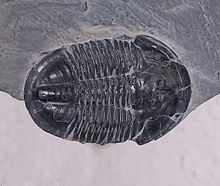
Back Paleosoïkum Afrikaans Paläozoikum ALS حقبة الحياة القديمة Arabic Era Paleozoica AST Sidlekeugal AVK Paleozoy Azerbaijani Палеазой Byelorussian Палеазой BE-X-OLD Палеозой Bulgarian প্যালিওজোয়িক Bengali/Bangla

Palaeozoicum[1] est aerathema stratigraphicum et aera geologica aeonis Phanerozoici infima. Palaeozoicum coepit abhinc annorum 541 000 ± 1 000 milium anni et abhinc annorum 251 902 ± 24 milium finem habuit. In sex periodos dividitur, quae ab infima ad supremam Cambrium, Ordovicium, Silurium, Devonium, Carboniferum, Permium appellantur.
Phanerozoicum, Palaeozoicum, Cambrium omnia incepta ex antiquissimis ichnofossilibus Treptichnus pedum dantur.
Nomen e verbis Graecis παλαιός 'antiquus' + ζῷον 'animal' ab Adamo Sedgwick anno 1838 Anglice sub forma Palæozoic series compositum est ut systemata Cambrium et Silurium comprehendat.[2][3]
- ↑ "Palaeozoicum": Robertus Koeppel, Praelectiones geologiae et praehistoriae pars 1 iii (Romae, 1933) p. 5 (Paginae selectae apud Google Books).
- ↑ Adam Sedgwick, "A synopsis of the English series of stratified rocks inferior to the Old Red Sandstone, with an attempt to determine the successive natural groups and formations" in Proceedings of the Geological Society of London 2 (1838), 675–85, vide p. 685.
- ↑ De historia nominis definitionisque vide: Mary Grace Wilmarth, The Geologic Time Classification of the United States Geological Survey Compared With Other Classifications, accompanied by the original definitions of era, period and epoch terms (United States Geological Survey Bulletin no. 769. Vasingtoniae: U.S. Government Printing Office, 1925) (p. 10 apud Google Books).